

One-celled organisms, also called single-celled or unicellular organisms, must carry out all the functions that a multicellular organism needs to live, including eating, getting rid of waste, reproducing, etc. The most abundant one-celled organisms are bacteria. Bacteria are prokaryotic, so lack the nucleus and distinct organelles of eukaryotic organisms. One-celled, eukaryotic organisms include organisms from the Kingdom: Protista and include plant-like algae, animal-like protozoa, and fungi-like slime molds.
In a drop of pond water, there can be many unicellular (and multicellular) organisms. In the illustration below, there are several different microorganisms.
Amoeba are one-celled organisms that live in wet environments including ponds, wetlands, wet soil, and even human bodies. They have a movable shape and can extend pseudopods to reach for and engulf prey. They prey on smaller organisms, such as bacteria. For illustrated diagrams of amoeba, click here.
Paramecium are one-celled organisms that are covered in hair-like cilia that beat to propel them in a spirals through their aquatic environments. They feed on bacteria and other small protozoans. For illustrated diagrams of paramecium, click here.
Euglena are one-celled protozoans with a whip-like flagellum that they use to propel themselves through their aquatic environment. Some euglena species have chlorophyll, so can produce their own food through photosynthesis. For illustrated diagrams of euglena click here.
To help understand living things, scientists break them down into groups by their traits. This is called, biological classification. Presently, there are 8 levels of groups: Domain, Kingdom, Phylum, Class, Order, Family, Genus, Species. New discoveries in genetics may cause some regrouping of organisms and their classification over time.
The 3 Domains are the highest level of classification to date. They include all known living things on Earth – Archaea, Eubacteria and Eukaryota.
The Eubacteria Domain is made up of bacteria – single-celled living things – also called microorganisms. They have no cell nucleus or organelles so are prokaryotes. Bacteria is found everywhere on Earth from the soil under our feet to inside our bodies. It can cause many human illness, but is also vital to life on Earth. The study of microorganisms is called microbiology.
The Archaea Domain also has single-celled microorganisms (prokaryotes), however, archeons can survive extreme conditions like scalding hotsprings and very salty areas. A relatively recent discovery, they are still being studied and updated.
The Eukaryota Domain has more complex organisms with cells that have a nucleus and organelles. They are eukaryotes. This domain is, at present, broken down into 4 Kingdoms: Protista, Fungi, Plantae, Animalia.
The Protista Kingdom, about which we are focusing today, is a diverse group, including plant-like algae, animal-like protozoans and fungi-like slime molds.
The diagram below shows how scientists classify the different kinds of unicellular organisms found on Earth.
When you research information you must cite the reference. Citing for websites is different from citing from books, magazines and periodicals. The style of citing shown here is from the MLA Style Citations (Modern Language Association).
When citing a WEBSITE the general format is as follows.
Author Last Name, First Name(s). "Title: Subtitle of Part of Web Page, if appropriate." Title: Subtitle: Section of Page if appropriate. Sponsoring/Publishing Agency, If Given. Additional significant descriptive information. Date of Electronic Publication or other Date, such as Last Updated. Day Month Year of access < URL >.
Amsel, Sheri. "Unicellular Organisms Overview and Classification" Exploring Nature Educational Resource ©2005-2024. December 13, 2024
< http://www.exploringnature.org/db/view/Unicellular-Organisms-Overview-and-Classification >

